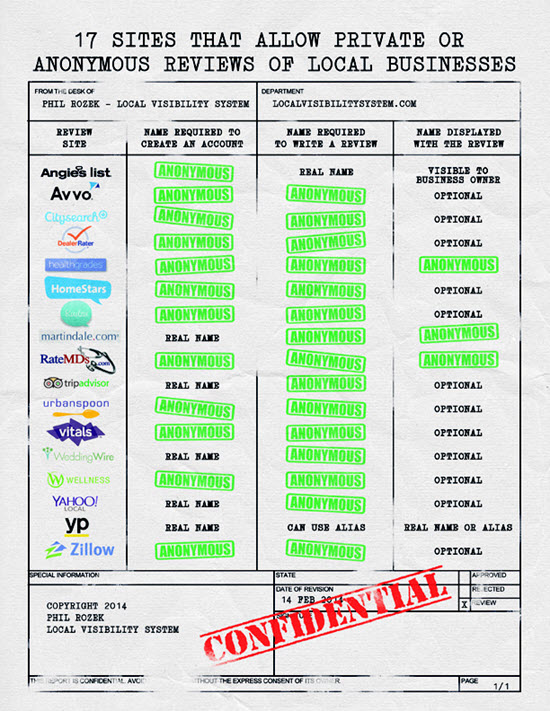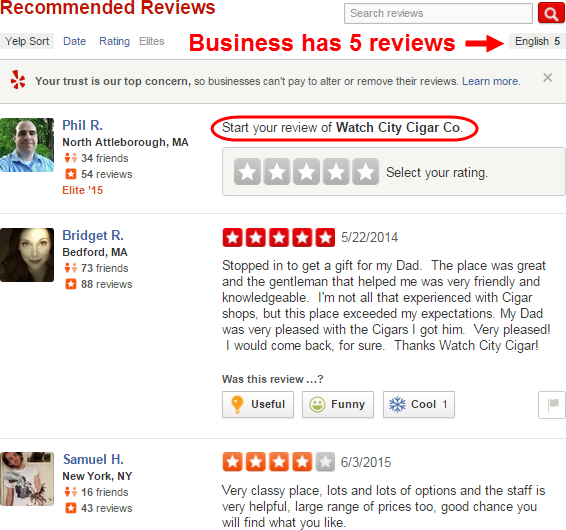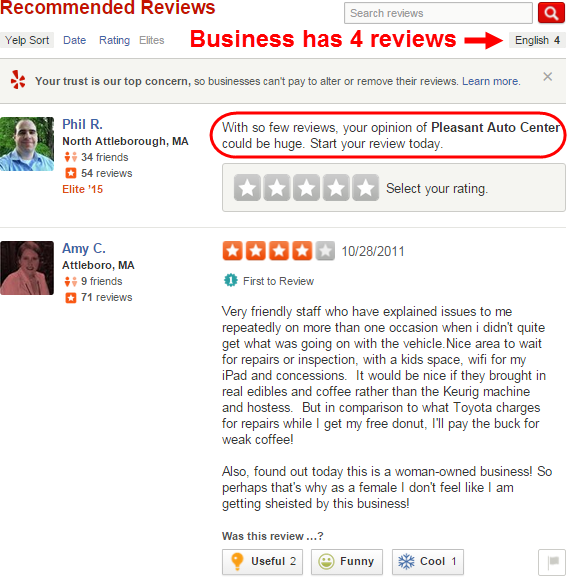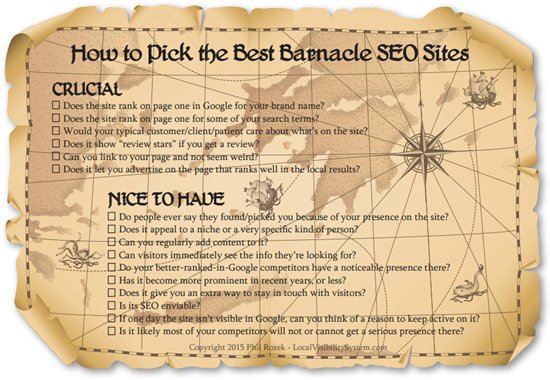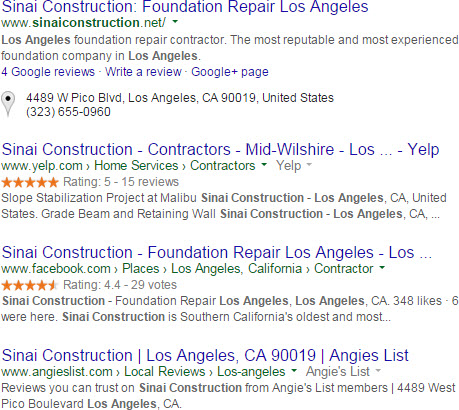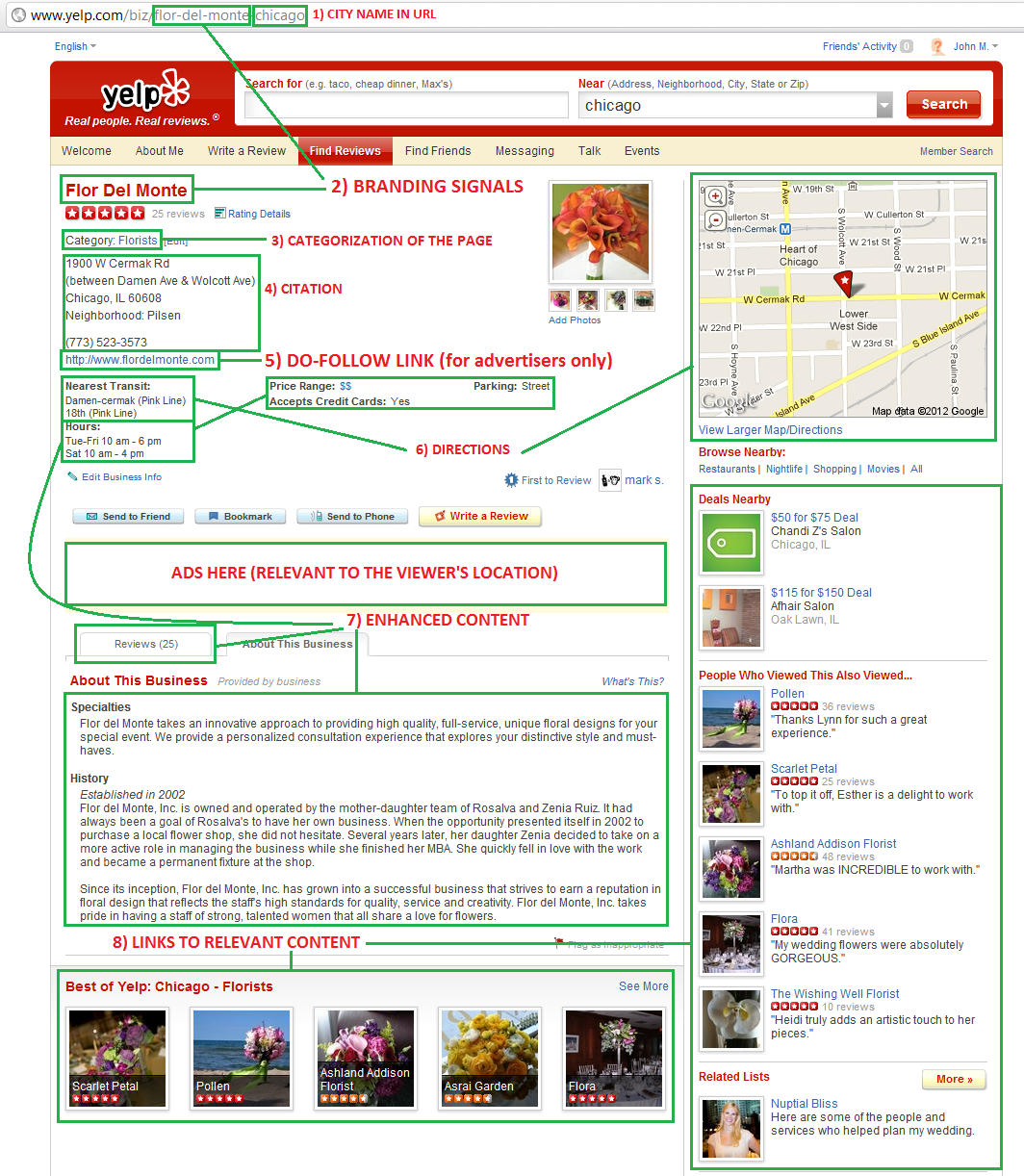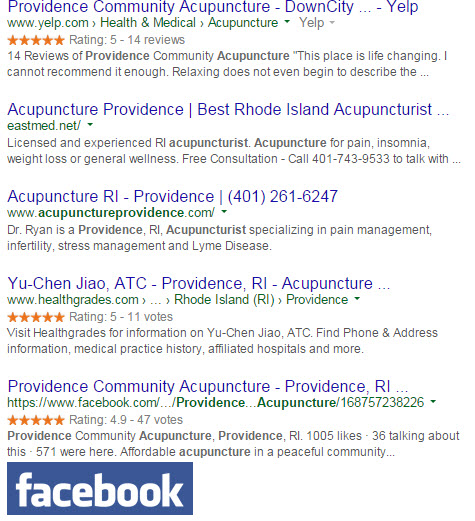Most business owners know they need online reviews if they want to get more customers. Some of them have actually tried to get happy customers to speak up. Very few get anywhere.
Even if the business owner makes a reasonable request at an appropriate time, customers still have to follow through. But they forget, or get distracted, or get confused, or aren’t asked to write a review on a site they find convenient, and so on. The business owner gets frustrated and concludes reviews are impossible to get and not worth the effort. He or she then loses would-be customers to someone else.
One thing I hang my hat on is being able to help business owners put together and execute on a review strategy that works: better reviews, more reviews, and more customers. I’m talking about getting reviews on Google+, Yelp, Facebook, other sites you and I are familiar with, and on industry-specific sites.
I’ve taken part in gnarly failures and bust-out-the-Champagne successes. I’ve worked with clients in more industries than you can shake a stick at (and have made review handouts for many more), and know all the things that can go wrong and what you really want to get right.
On the one hand, it’s a simple trinity: do right by your customers, provide instructions that they find easy to follow, and ask whenever possible. As long as everything you do is with those principles in mind, you’ll do fine on reviews.
But on the other hand, the devil is in the details. Also, you may be in a tricky situation (e.g. you’re a therapist or bankruptcy lawyer). Or maybe you just want to go from good to world-class.
I’ve rounded up all the 64 questions I use to determine how my clients can get their review strategy on-track.
If you’re a business owner you’ll want to ask yourself these. If you work for the business owner you’ll want to see how many of these you can sniff out on your own, and then have your boss or client fill in the gaps
I’ve also put together a Google Drive doc of all the questions – just the questions, without my explanations underneath them.
You probably won’t have to address all the questions. I list 64 here simply to cover all the possible issues your review strategy might have run into.
FYI, it might be tough to use this as a checklist. Some questions a “yes” answer is good, for others a “no” answer is good, and for other questions you might want a different type of answer.
Happy troubleshooting!
Basic questions
1. Do you want to get more reviews?
Some business owners think reviews are too hard to get, or that in their unique situation getting reviews is impossible, or that customers don’t care about reviews. Usually they end up agreeing with me that none of that is true, but some people are dead-set in their thinking. If that’s you or your client, the rest of these questions probably won’t help you much.
2. Are most of your customers happy?
If they’re not, you should still try to get the happy ones to speak up, but you may have a bigger challenge to work on in the meantime.
3. What have you tried so far?
Broad question here, but that’s because there are so many possible answers. The answer will give you an idea as to what other diagnostic questions (see below) to ask next.
4. Do you provide easy-to-follow instructions for writing a review?
As opposed to simply making a request and assuming customers know what to do.
5. Do you offer reviews a choice as to the site?
Don’t focus too much on Yelp and Google+: they’re the only sites that really filter reviews (especially Yelp), and Google’s steps for posting a review are cumbersome and not clear to most people. Steer at least some customers toward easier sites, and maybe use my “zigzag” strategy. But you’ll want to diversify where you get reviews anyway, and that’s one way to do it. I suggest you offer customers 3-6 choices.
6. In what medium have you been asking for reviews?
Do you ask in-person, by email, by phone, on invoices, or what? If you’ve only tried one method of asking for reviews, try another method – or ideally a combination.
7. Do you know which customers are happy?
The worst thing to do is not to ask anyone because you’re so afraid someone might write a bad review. It’ll happen eventually, if it hasn’t happened already. But you want to get the happy customers to speak up, and asking them is the only good way to do it. If you can’t tell who’s happy, just ask. It can be as subtle, like, “So, is there anything else we can do for you today?” Then ask for a review if it seems like a good idea.
8. When you’ve asked customers for reviews, how did they react?
Did they say yes when you asked in-person, but never followed through? Or did they ask whether they have to use their full name? Did they snail-mail you a testimonial – rather than post an online review? Their reactions will tell you what to change, or at least which diagnostic questions to ask yourself next.
9. Do you know the laws or regulations on reviews in your industry?
The financial-consulting industry is the only one I know of where you just can’t ask for online reviews, according to the SEC. My understanding has always been that doctors and psychotherapists can ask for reviews if they ask patients in an FTC-compliant way and if they tell patients that they don’t need to get into specifics (as per HIPAA). Get the facts if you have any doubt as to the legality of your review strategy. Don’t let uncertainty make you beat around the bush and not encourage happy customers to speak up. Oh, and you don’t want to get in hot water.

10. How likely is it that your customers / clients / patients would have privacy concerns if they used their full name to post an online review of you?
Make sure they know two things: (1) they don’t have to describe anything too specific or personal – they can focus on describing you and your service – and (2) they can review you on private / anonymous sites.
11. How long have you been trying to get more reviews?
You don’t know how well your strategy works if you’ve only tried it for a month, or you’ve asked fewer than about 20 customers, or if you’re new to the whole idea of asking for reviews. Try it for long enough that you can draw conclusions, and then tweak or change gears as needed.
12. How long have you tried whatever strategy you’re currently using?
Give it a chance. But be willing to change it or try something else if it doesn’t seem to work (see below questions).
13. Do you have a problem with passive ways to encourage reviews (ways that don’t involve asking specific people directly)?
Add review badges or widgets to your site, consider copying and pasting reviews and featuring them throughout your site (see this and this), link to your reviews in your email signature, and include instructions on the “Reviews” page on your site. You won’t get a ton of reviews, but these indirect methods may help you get a trickle. Do this if you’re gun-shy about asking directly.
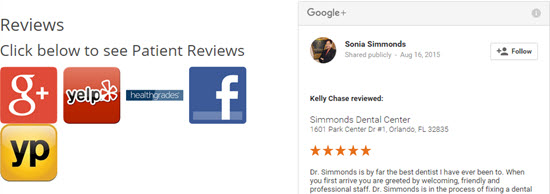
14. How often do your customers’ reviews get filtered?
Having lots of filtered reviews (on Yelp and Google+) can be a good sign: it means people are following through. Something’s working.
Setting the stage
15. Do the names of your online listings closely match the name your customers / clients / patients know you as?
They may not even be finding the listings they want to post reviews on. Work on your listings and make sure you can pull up the correct listings.

16. Do you know for a fact that you don’t have any duplicate listings on the sites where you want reviews?
They may be posting reviews on the wrong listings. Find the duplicates and fix or remove as many as you can.
17. Do customers know that you will personally read and acknowledge their reviews?
Say so in your request. Make it clear you’re looking for honest feedback, not just 5 stars. Also, post responses to at least some of the reviews. You don’t want reviewers to feel they’re shouting into the wind.
18. Have you posted overheated responses to reviews?
Don’t scare people off. Respond to negative reviews if you feel you need to, but don’t lose your cool. Sleep on it before posting a response, and see if you can turn lemons into lemonade.
19. If you’ve already got any reviews, do your customers know about them and know that they won’t be the first?
They’ll feel more comfortable if there are precedents. It’s good if you can point to reviews that aren’t too long or personal, so that reviewers don’t feel daunted. But then how do you get your first review? Either by accident (from someone you didn’t expect to write one), or by asking enough people, or by reaching someone who wants to be the first because he/she is a really happy customer and wants you to stay in business.
20. Have you personally ever written an online review of a “local” business?
Do it. Know what’s involved, and what you’re asking people to do. Ideally you know what it’s like to write a review on the specific site(s) you’re asking customers to review you on. (That’s half the reason I review businesses on Yelp.)
21. How do most of your customers find you originally?
The ones who found you online are more likely to have checked out your reviews, to care about reviews, and to recognize their value to you and to other customers. You’ll still have to work to get them to review you, but the point is they’re a little better-conditioned than are word-of-mouth referrals (for example). To any customers who didn’t find you online you’ll probably need to explain why reviews matter to you, show how easy it is to post one, and provide step-by-step instructions.
Whom to ask
22. Have you asked your very best, closest, most-loyal customers?
Give them a choice of at least two sites, give them simple instructions for each (more on that topic later), and follow up if they haven’t written you a review after your initial request. Chances are they’ll review you. If so, you probably have a workable strategy, and can start asking other customers. (If they don’t review you, use the other questions to figure out why.)
23. Take 5-10 customers you asked for a review – or plan to ask for a review – and look them up on Google+, Yelp, and Facebook: how many of them have ever written reviews of other businesses?
Customers who already write reviews understand why reviews matter to you, and probably don’t need much hand-holding. You can also discover which site(s) they might prefer to review you on.
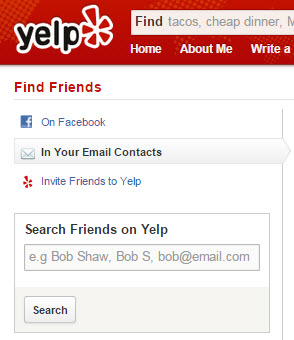
24. Have you read the reviews you’ve already got and understood exactly what kind of people end up reviewing you?
If you can identify a type of person who’s likely to review you, you may have a better idea of whom to ask (and not to ask).
25. How would you describe most of your customers’ economic situation?
Some groups of people are more likely to use their phones for most things they do online. Make sure you give mobile-centric review instructions to customers who may not have much access to (or use for!) a desktop / laptop.
26. How old is your typical customer? (Or if your customers fall into several age groups, what are the biggest 1-2 age groups?)
Sweeping generalization here: younger customers are a little more inclined to write you a review on mobile, whereas older ones might be warmer to a desktop / laptop.
Who asks
27. In your company, who besides you might be able to ask customers for reviews?
Don’t want to ask customers yourself? Don’t want to ask all of them yourself? Want to run a “test” and figure out who’s the best? Distribute the work, at least for a while.
28. Who do you think would be the best person in your company to ask for reviews, and why?
Maybe you’re the boss and know your business best, but maybe Sara at the front desk has the relationship with customers, and might just be more charming than you. Or maybe Louie is your best tech and would haul in the reviews, if only you could get him to start asking.
29. Even if someone else usually asks customers for reviews, have you ever tried asking customers yourself?
Just so you can speak from experience, and tweak your strategy based on experience.
30. Have you heard or seen exactly how people in your organization ask customers?
Do they emphasize that the review is a favor, and not an obligation? Do they provide clear instructions? Are they patient? Are they polite to customers who don’t want to write a review? Do they thank all customers? Listen to some phone calls and read the emails. Whether you do that openly or channel your inner Dick Cheney is up to you. Just as long as it leads to a constructive talk.

When to ask
31. When do you ask customers?
Your initial request should be right after the job is done, if possible, and then you should follow up within about a week. You probably won’t have your best results if you let a month go by, or if you only ask immediately after the job is done. (More on the topic of following up later.)
32. Does at least one of your requests happen when the customer is in a position to write you a review immediately if he or she wants to?
Some people are more likely to follow through on the spot, rather than later.
33. Have you tried asking at different times?
Ask on a different day, or at a different time of day, or both. In particular, test if it seems to make a difference whether you ask during the week or on the weekend.
What to ask
34. Do customers know you’re asking for an online review on a third-party site – not simply a testimonial that they let you stick on your site?
Too many business owners have told me, “Yeah, I have tons of reviews – I have a whole bag of ‘em in my office!” No, those perfumed letters are testimonials, which presumably your customers gave you permission to put on your site. I’m talking about online reviews, which people can post whether you ask them to or not, and which you can’t edit or cherry-pick. Make sure your customers know the difference and know what you’re requesting.
35. Do you encourage honest (even critical) feedback?
You don’t want your review corpus to look fishy. But you do want to know how to provide a better service – for obvious reasons, and so you can earn even more “review stars” long-term. Also, if you’re the type who’s concerned about asking customer for reviews only to have them leave you bad ones, encouraging honest feedback means you’re less likely to gall the less-happy customers. They’re less likely to think, “How DARE they ask me for 5 stars – I’ll show ‘em where they can stick their 5 stars….”
36. Which site(s) do you ask customers to review you on?
Try a different site. Preferably one that’s less painful than Yelp or Google+. If you get reviews there, you’ll know you’re at least on the right track.
37. Do you comply with the rules of the sites where you want more reviews?
The consequences of ignoring Yelp’s polices can be pretty ugly. Once upon a time Google+ reviews were also policed, and although now it’s no neighborhood for Mr. Rogers, you should still follow the rules.
38. Have you avoided incentivizing reviews with things like gift cards or discounts?
It’s cheesy, ethically questionable, and might insult some customers (who may beat you over the head with it in their reviews). Your payola will probably work, if your definition of success is simply getting reviews. But those reviews will probably be short and pro forma and not too compelling to would-be customers, or they’ll look outright crooked.
39. Do you make it clear which review site is your “first choice”?
You need to offer choices, but not so many that your reviewer freezes. (As I mentioned before, I suggest asking any given reviewer to choose from one of 3-6 sites.) They may also freeze if they have to decide between sites. Provide a slight nudge.
40. Do you ask any one customer to review you on more than one site?
Don’t turn it into a big chore, or make it seem that way. You may be able to ask a customer who just successfully wrote you a review on one site to review you on another, but it would have to be a customer you’re pretty close with, and even then you wouldn’t want to wear out your welcome.
41. If a customer seemed ready to write you a review on the spot, do you know exactly what you would ask that person to do?
Once in a blue moon, you may ask in-person for a review and your customer will say, “Sure. I’ve got my phone right here. Tell me what to do.” Know what you want him or her to do.
42. Do you tell customers roughly how long it will take to write a review?
Tell everyone that you appreciate a short review, but that you also love detail. You’re respecting their time either way. That’s a good way to get reviews from people who’d otherwise think it’s a pain and not bother, and to get the juicy, keyword-rich, in-depth, helpful reviews that can really convert readers into customers.
How to ask
43. Do you make your review request sound like a personal favor (and not an obligation)?
You’re more likely to get a review, and you’ll stay classy.

44. Do you email a bunch of customers at once?
Don’t. Especially early on. You don’t want to send an ineffective or ill-timed request, have it flop, and then have no more customers to ask. (And if you’re using a personal or email account you don’t want to get in hot water with your ISP.) Your reviews might also get filtered (at least on Yelp and Google) if too many people try to review you at once. If you must request reviews in batches, keep the batches small (5-15 people).
45. To what extent do you personalize each request?
I’m far more likely to review you if you say “Hey Phil” or “Mr. Rozek” than if you say “Dear Valued Customer,” even if the rest of the email is boilerplate. And I’m way more likely to put in a good word for you if you allude to the specific service or product I paid for, or a conversation we had, or build off some rapport. The more bespoke your request, the better. Of course, that’s hard to “scale,” so pick your poison.
46. Do you ask customers in more than one medium?
In my experience, the best is to ask in-person with printed instructions (like these) and later to follow up by email. But you may find that snail-mail or a phone call or a review-card / review-page work well for you.
47. Have you tried any tools?
You should. Don’t expect them to work without any strategy or finesse on your part. Don’t rely on them 100%, or stop experimenting even if they work well. But tools like Grade.us and GetFiveStars (my personal recommendations) can serve you well.
48. If the tools you’ve tried haven’t worked so well, have you tried others?
Again, you’ll probably need to experiment before you find a tool that helps. (But again, don’t expect it to haul in reviews without any thinking or effort on your part.)
49. Have you relied solely on tools like DemandForce or SmileReminder?
These tools have their place in the world, but the trouble is that (last I checked) the reviews just sit in a walled garden on DemandForce.com or SmileReminder.com, because that’s where patients / clients write them. They aren’t going to Yelp or Google+ or Facebook or HealthGrades or wherever. I’ve seen businesses (usually medical practices) with 500 reviews on, say, DemandForce.com, but none on Google. You need some reviews on the BIG sites – no matter how hard it is to get them – and you need diversity.
Your instructions
50. If you tell customers that you’d like a review on any of a variety of sites (rather than just one), do you give them instructions for how to post a review on each of those sites?
Google+ is the site where they’ll probably need the most guidance, but you should provide at least rough instructions for whatever other sites you care about.
51. Do you know for a fact that your review instructions are up-to-date?
On Google+ the steps change on average about once a year. Facebook probably has tweaked them a couple of times, too.
52. Do you make it simple for people to review you on any device?
Make sure they know whether to use their phones or desktops (if it matters), and make sure mobile reviewers know whether they need to download an app and that shorter reviews are OK. If you send follow-up emails make sure to send a test email to yourself, and pull up the email and walk through the steps both on your desktop and on your phone. Try your best to the stumbling blocks before would-be reviewers do.
53. Do your printed instructions look well-designed and feel like good paper?
Consider printing on a thicker stock. Or laminating your instructions. Your request will seem more thought-out, and people will be less likely to use them to scoop up cat hairballs.

54. If you’re using a “Review Us” page, do you link to instructions on how to post reviews?
It would be a shame not to: the customer is happy enough and cares enough to have visited your page. Make it easy from here. Nice examples here and here.
Following up
55. Do you follow up on your initial request?
Just because they haven’t reviewed you doesn’t mean they won’t. They forget, or their spouse hits them with the honey-do list, or your nice printed instructions enter the Doomsday Machine of papers on the kitchen table. Follow up once. Be nice and casual. You won’t be considered a pest.
56. Do you follow up in a different medium from the one you used to ask the first time?
If you ask in-person, maybe follow up by email. If you only sent an email, ask the customer in-person next time, or maybe send snail-mail. Experiment.
57. Does your follow-up include (or point to) instructions for how to post a review?
For the same reasons you included instructions the first time around. Make it easy to say yes.
58. Does your follow-up seem automatic or stuffy?
Make it as customized (or even more so if possible) than your initial request.

Other troubleshooting questions
59. Do your customers accidentally review the wrong business?
Check competitors’ listings for your reviews – especially if those competitors’ businesses are named similarly to yours. Report those reviews and show how they’re for the wrong business. (They may not get transferred to you
60. Have you tried to learn from anyone who’s got more / better reviews than you, or who just has a lot of experience with online reviews?
Don’t cut corners if they cut corners, but see if there are any smart moves you can try.
61. How many of the reviews you’ve already got are from people you asked for a review, versus how many were written spontaneously?
If nobody reviews you unless you ask, you know you need to ask. On the other hand, having more than a few spontaneously written reviews means customers probably don’t find it tough or uncomfortable to review you, so the wind may be at your back if you just start asking.
62. Have you had a little success on some review site(s), or do you have difficulty getting reviews on any site?
Having reviews somewhere probably means that they’re willing to put in a good word for you, but just need better-timed requests or reminders or clearer instructions. It also means you could probably pile on more reviews there without too much effort. Where you’ve got reviews so far may even tell you where those customers found you to begin with.
63. How many of your customers have connected with your business on Facebook in some way?
That makes it real easy to ask for reviews on sites that accept Facebook logins – where customers don’t have to go to the trouble of setting up an account on a site just to review you.
64. How do you encourage unhappy customers to update their reviews to be more favorable?
Get in contact and fix any issues you can, if possible. If you can make that angry customer happier, ask if he or she will update the review to reflect that.
—
I hope that wasn’t overblown like an ‘80s power ballad, but I also hope you don’t say I wasn’t thorough.
Use the questions to tweak your strategy. It will pay off.
Here’s the link to the questions-only Google Drive doc again.
Thanks to Alex Deckard of CAKE Websites for kicking around some ideas with me.
In your efforts to get reviews, have you run across a problem that my troubleshooting questions wouldn’t address?
Any questions or suggestions that are unclear? Any others you can think of?
How about any questions that gave you a “Eureka” moment?
Leave a comment!


